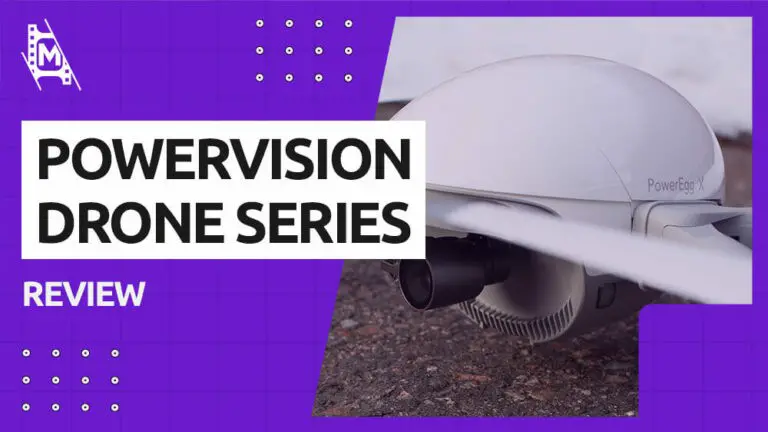When someone mentions drones, DJI is probably the first brand that comes to mind. But there are many drone makers out there that bring unique ideas and inventiveness to this market that have yet to be discovered.
One of them is PowerVision, who has allowed us to review some of their products and, through our collaboration, introduced us to their drone series.
After doing a hands-on review of their flagship drone, the PowerEgg X, we thought it would be cool with an article looking at their entire drone series. We will look at their unique product line of aerial and marine drones and explore if they are a fit for videographers.
Aerial Drones
PowerEgg X
Let’s begin with PowerVision’s flagship drone, which features a unique egg-shaped design and foldable arms for easy portability. It is equipped with a 4K UHD camera and has a flight time of approximately 30 minutes.
It features obstacle avoidance sensors, GPS and GLONASS positioning, and an automatic return-to-home function. Additionally, it has an intelligent tracking feature that allows it to automatically detect and track moving objects, such as people or vehicles, while capturing footage.
This is all standard for most drones today, but with the PowerEgg X Wizard kit, you can fly in the rain and land/take off from water. The drone body also has removable arms, which allows you to use it as a handheld camcorder with its in-built gimbal.
It is safe to say their flagship drone allows for some pretty impressive versatility, but it has flaws. Feel free to check out our review of the PowerEgg here to see if it would suit you.
PowerEye
PowerVision’s PowerEye is a more professional-grade drone designed for aerial photography and cinematography. Unlike the PowerEgg, this drone has a more advanced 3-axis gimbal for stabilization and smooth movements. The PowerEye also has a slightly shorter flight time of up to 39,5 minutes and a maximum speed of 18 m/s.
Its biggest advantage is that the lenses on the camera are replaceable, supporting a total of 14-42mm in focal length. These are the lenses listed on their official website:
- Panasonic Lumix G 14mm F2.5 ASPH (Standard)
- Olympus M.Zuiko 17mm f/1.8
- Olympus M.Zuiko ED 14-42mm f/3.5-5.6 EZ (zoom)
- Olympus M.Zuiko 25mm f1.8
- Olympus M.Zuiko 45mm f1.8
Overall, this is the camera to get if you want to capture higher-quality video for projects going beyond the limits of PowerEgg.
Marine Drones
PowerVision also offers a range of marine drones designed for underwater exploration and photography. Here is their current line-up:
PowerDolphin
The PowerDolphin is a remote-controlled, waterproof drone designed for fresh and saltwater environments. It can reach speeds of up to 10 mph in still water with a battery life of approximately 2 hours.
While equipped with a 4K UHD camera, there are probably better cameras for underwater videography as the video quality is limited, only allowing for MP4 recording.
Instead, this is a more practical underwater drone that can be used for either home video or fishing. It also features a cool sonar mapping feature, allowing you to capture the terrain of the seabed.
PowerRay
For underwater videography, PowerRay is the better option. It features a 1/2.3 inch CMOS sensor allowing for up to 12MP stills and 4K video at 25fps. You also have ISO control with a range of 100-1600.
In terms of its underwater capabilities, it can dive up to 98 feet, or about 30m, and has a battery time of up to 4h. It also has a sonar mapping feature and, in addition, a powerful LED front light.
The PowerRay is tethered with a 120feet cable, allowing you to live-stream underwater video.
Are Their Products Worth the Price Tag?
Overall, PowerVision is a company with high potential. Their PowerEgg X Wizard can take off and land in the water, and their PowerDolphin can dive up to 30 meters underwater, while the PowerRay allows you to capture underwater video without having to earn a SCUBA license and invest in expensive waterproof housing for your primary camera! Yet, their products have so many features, making it difficult to know exactly what niche they are targeting, as our PowerEgg X review proved.
In addition, all of their drones are pretty expensive. Their flagship drone, the PowerEgg X, will cost you around 1200 dollars with the “Wizard” kit. So are their drones worth the price tag?
In terms of traditional video drones, DJI is still superior in both build and video quality. But PowerVision has drones that fulfill some exciting niches. Some might want to live-stream fishing, underwater exploring, or be able to take off a drone from water.
If you need these features PowerVision offers, their products could be for you. Just make sure to read through and understand their features before buying. It will be interesting to see how their products evolve as they mature.
